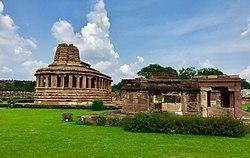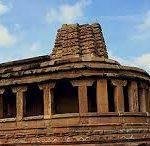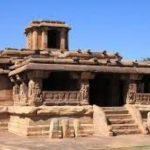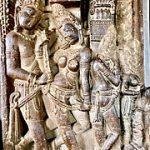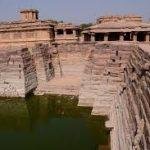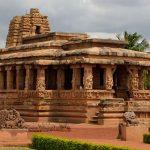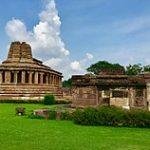Aihole, Bagalkot, Karnataka
| Date built: | 4th–12th century CE |
|---|---|
| Deity: | – |
| Architectural style: | – |
| Major festivals | – |
| Locale: | Bagalkot, Karnataka, India |
| District:: | Bagalkot |
| Address: | – |
| Phone | – |
Aihole (pronounced “Eye-hoé”), also referred to as Aivalli, Ahivolal or Aryapura, is a historic site of ancient and medieval era Buddhist, Hindu and Jain monuments in north Karnataka (India) dated from the fourth century through the twelfth century CE.Located around an eponymous small village surrounded by farmlands and sandstone hills, Aihole is a major archaeological site featuring over one hundred and twenty stone and cave temples from this period, spread along the Malaprabha river valley, in Bagalakote district.
Aihole is 22 miles (35 km) from Badami and about 6 miles (9.7 km) from Pattadakal, both of which are major centers of historically important Chalukya monuments. Aihole, along with nearby Badami (Vatapi), emerged by the 6th century as the cradle of experimentation with temple architecture, stone artwork, and construction techniques. This resulted in 16 types of free-standing temples and 4 types of rock-cut shrines.The experimentation in architecture and arts that began in Aihole yielded the group of monuments at Pattadakal, a UNESCO world heritage site.
Over one hundred Aihole temples are Hindu, a few are Jain and one is Buddhist. These were built and coexisted in close proximity. The site is spread over about 5 square kilometres (1.9 sq mi).The Hindu temples are dedicated to Shiva, Vishnu, Durga, Surya and other Hindu deities. The Jain Basadi temples are dedicated to Mahavira, Parshvanatha, Neminatha and other Jain Tirthankaras. The Buddhist monument is a monastery. Both Hindu and Jain monuments include monasteries, as well as social utilities such as stepwellwater tanks with artistic carvings near major temples
Architecture
Legend / Local stories
Aihole is referred to as Ayyavole and Aryapura in its inscriptions and Hindu texts from 4th to 12th century CE, as Aivalli and Ahivolal in colonial British era archaeological reports.
Aihole has been a part of Hindu mythologies. It has a natural axe-shaped rock on the Malaprabha river bank north of the village, and a rock in the river show a footprint.Parashurama, the sixth Vishnu avatar, is stated in these legends to have washed his axe here after killing abusive Kshatriyas who were exploiting their military powers, giving the land its red color.A 19th-century local tradition believed that rock footprints in the river were those of Parashurama.A place near the Meguti hillocks show evidence of human settlement in prehistoric period. Aihole has historical significance and has been called a cradle of Hindu rock architecture.[20]
The documented history of Aihole is traceable to the rise of the Early Chalukya dynasty in 6th century. It became, along with nearby Pattadakal and Badami, a major cultural center and religious site for innovations in architecture and experimentation of ideas. The Chalukyas sponsored artisans and built many temples in this region between the 6th and 8th centuries.Evidence of wooden and brick temples dating to 4th-century have been unearthed. Aihole started the experimentations with other materials such as stone around the 5th century when the Indian subcontinent saw a period of political and cultural stability under the Gupta Empire rulers. Badami refined it in 6th and 7th centuries. The experimentations culminated in Pattadakal in the 7th and 8th centuries becoming a cradle of fusion of ideas from South India and North India.
The Aihole fort rubble walls on Meguti hill enclosing the 5th-6th century Jain temple.
After the Chalukyas, the region became a part of the Rashtrakuta kingdom who ruled in the 9th and 10th century from the capital of Manyakheta. In the 11th and 12th century, the Late Chalukyas (Western Chalukya Empire, Chalukyas of Kalyani) ruled over this region.Even though the area was not the capital or in immediate vicinity from 9th to 12th centuries, new temples and monasteries of Hinduism, Jainism and Buddhism continued to be built in the region based on inscriptional, textual and stylistic evidence. This likely happened, states Michell, because the region was prosperous with a substantial population and surplus wealth.
Aihole was fortified by Late Chalukya kings in the 11th and 12th centuries, in an approximate circle. This indicates the strategic and cultural importance of Aihole to the kings whose capital was far away. Aihole served as a hub of Hindu temple arts in this period with guild of artisans and merchants called the Ayyavole 500, celebrated for their talent and accomplishments in the historic texts of the Deccan region and South India.
An 8th-century Shiva temple was renamed Lad Khan Temple after a Muslim commander of Bijapur Sultanate who briefly lived here.
In the 13th century and thereafter, the Malprabha valley along with much of Deccan became a target of raids and plunder by the Delhi Sultanate armies devastating the region. From the ruins emerged the Vijayanagara Empire which built forts and protected the monuments, as evidenced by inscriptions in the fort at Badami. However, the region witnessed a series of wars between Vijayanagara Hindu kings and Bahmani Muslim sultans. After the collapse of Vijayanagara Empire in 1565, Aihole became a part of the Adil Shahi rule from Bijapur, with some of the Muslim commanders using the temples as residence and their compounds as garrison for storing weapons and supplies. A Hindu temple dedicated to Shiva came to be called Lad Khan temple, named after the Muslim commander who used it as his operational hub, and a name that has been used ever since.In late 17th-century, the Mughal Empire under Aurangzeb gained control of the region from Adil Shahis, after which Maratha Empire gained control of the region. It again changed hands with Haider Ali and Tipu Sultan conquering it in late 18th century, followed by the British that defeated Tipu Sultan and annexed the region.
The monuments at Aihole-Badami-Pattadakal show the existence and a history of interaction between the early northern style and early southern style of Hindu arts.According to T. Richard Blurton, the history of temple arts in north India is unclear as the region was repeatedly sacked by invaders from Central Asia, particularly the Muslim incursion into the subcontinent from 11th-century onwards, and “warfare has greatly reduced the quantity of surviving examples”. The monuments in this region are amongst the earliest surviving evidence of these early religious arts and ideasArchaeological site
Aihole became a significant archaeological site and attracted scholarly attention after the British India officials identified and published their observations.The colonial era scholars hypothesized that the Apsidal shape Durga temple in Aihole may reflect the adoption by Hindus and Jains of the Buddhist Chaitya hall design and the influence of early Buddhist arts. They also identified historically significant 7th-century inscriptions.
For much of the 20th-century, Aihole remained a neglected site. Until the 1990s, the site consisted of houses and sheds built up to and in some cases extending into the historical monuments.The walls of the ancient and medieval temples were shared by some of these homes. Investments in infrastructure, land acquisition and relocation of some residences has allowed limited excavations and created a few dedicated archaeological parks including one for the much studied Durga temple at Aihole. Excavated ancient and medieval era artifacts and broken temple pieces, including a complete life size nude Lajja Gauri in birthing position and with a lotus head,now resides in an ASI museum next to the Durga temple in Aihole. Many temples and monasteries continue to be set midst narrow streets and congested settlement.
The Aihole site and artwork are a major source of empirical evidence and comparative studies of Indian religions and art history in the Indian subcontinent.The Aihole’s antiquity, along with four other major 5th to 9th century sites – Badami, Pattadakal, Mahakuteshvara and Alampur – is significant to scholarship relating to archaeology and religions. These, states George Michell, display a “meeting and fragmentation of different temple styles and the creation of local variants”. This fusion and exploration of arts and ideas later became a part of northern and southern Indian architectural repertoires
Photo Gallery
How to Reach:
The Aihole monuments are located in the Indian state of Karnataka, about 190 kilometres (118 mi) southeast of Belgaum and 290 kilometres (180 mi) northeast from Goa. The monuments are about 14 miles (23 km) from Badami and about 6 miles (9.7 km) from Pattadakal, set midst rural villages, farms, sandstone hills and Malprabha river valley. The Aihole site preserves over 120 Hindu, Jain and Buddhist monuments from the 4th—12th century CE. The region is also a site for prehistoric dolmens and cave paintings.
Aihole has no nearby airport, and is about 4 hours drive from Sambra Belgaum Airport (IATA Code: IXG), with daily flights to Mumbai, Bangalore and Chennai.[14][15] Badami is the closest town connected by railway and highway network to major cities of Karnataka and Goa.[6] It is a protected monument under the laws of the Indian government, and managed by the Archaeological Survey of India (ASI).
Contact Details
Official Address

